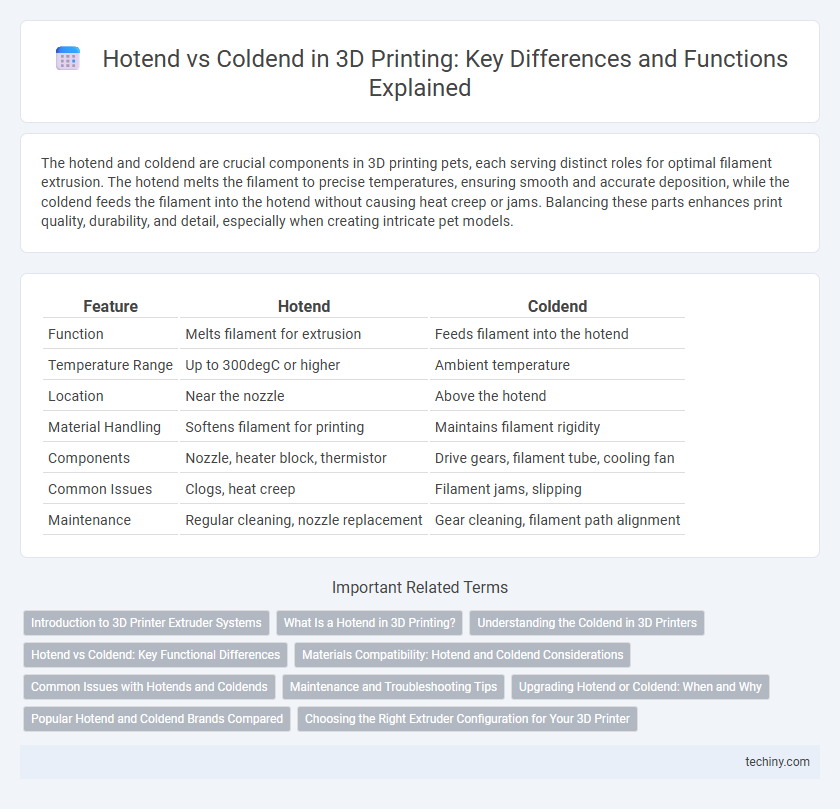The hotend and coldend are crucial components in 3D printing pets, each serving distinct roles for optimal filament extrusion. The hotend melts the filament to precise temperatures, ensuring smooth and accurate deposition, while the coldend feeds the filament into the hotend without causing heat creep or jams. Balancing these parts enhances print quality, durability, and detail, especially when creating intricate pet models.
Table of Comparison
| Feature | Hotend | Coldend |
|---|---|---|
| Function | Melts filament for extrusion | Feeds filament into the hotend |
| Temperature Range | Up to 300degC or higher | Ambient temperature |
| Location | Near the nozzle | Above the hotend |
| Material Handling | Softens filament for printing | Maintains filament rigidity |
| Components | Nozzle, heater block, thermistor | Drive gears, filament tube, cooling fan |
| Common Issues | Clogs, heat creep | Filament jams, slipping |
| Maintenance | Regular cleaning, nozzle replacement | Gear cleaning, filament path alignment |
Introduction to 3D Printer Extruder Systems
The hotend and coldend components are essential in 3D printer extruder systems, with the hotend responsible for melting filament and the coldend guiding it. Efficient heat management in the hotend ensures precise material flow and consistent layer adhesion during printing. Advanced extruder designs optimize coldend grip and minimize filament deformation, improving overall print quality and reliability.
What Is a Hotend in 3D Printing?
A hotend in 3D printing is the component responsible for melting the filament to enable smooth extrusion through the nozzle. It consists of a heater block, heating element, thermistor, and nozzle, working together to precisely control temperature for optimal material flow. Unlike the coldend, which feeds the filament, the hotend ensures consistent melting and deposition for high-quality prints.
Understanding the Coldend in 3D Printers
The coldend in 3D printers is the part responsible for feeding the filament into the hotend without melting it prematurely. It maintains a controlled temperature below the melting point of the filament to ensure smooth extrusion and prevent clogs. High-quality coldends incorporate efficient cooling mechanisms and precise drive gears to optimize filament flow and print quality.
Hotend vs Coldend: Key Functional Differences
The hotend and coldend are critical components of a 3D printer's extruder system, serving distinct functions in the filament extrusion process. The hotend heats and melts the filament, allowing precise deposition layer by layer, while the coldend grips and pushes the filament toward the hotend without heat impact, ensuring consistent feeding. Understanding the hotend's temperature control and the coldend's mechanical drive aids in optimizing print quality and preventing common extrusion issues like clogging or under-extrusion.
Materials Compatibility: Hotend and Coldend Considerations
Hotend components must withstand high temperatures to extrude a variety of thermoplastics such as PLA, ABS, PETG, and polycarbonate without degradation. Coldend parts primarily handle filament feeding and require materials resistant to wear and heat buildup to maintain consistent extrusion and prevent jamming with flexible or abrasive filaments. Optimizing material compatibility between hotend and coldend ensures reliable printing performance across a broad range of filament types.
Common Issues with Hotends and Coldends
Hotends often face issues such as clogging, inconsistent extrusion, and overheating, which can lead to filament jams and print defects. Coldends typically encounter problems like excessive backlash, poor filament grip, and heat creep, causing uneven feeding and filament slipping. Addressing these common hotend and coldend challenges improves print quality and reduces downtime in 3D printing operations.
Maintenance and Troubleshooting Tips
Regular maintenance of the hotend involves cleaning the nozzle to prevent clogs caused by filament residue and ensuring proper heat block insulation to maintain consistent temperatures. Coldend upkeep includes checking the extruder gears for filament debris and adjusting tension to avoid filament slipping or grinding. Troubleshooting common issues requires diagnosing jams by heating the hotend adequately and inspecting the coldend components for mechanical wear or misalignment.
Upgrading Hotend or Coldend: When and Why
Upgrading the hotend is essential when printing with high-temperature or abrasive materials, as it improves heat stability and nozzle durability, enabling better print quality and material compatibility. Coldend upgrades become necessary to enhance filament feeding reliability, especially when switching to flexible or specialty filaments that require precise extrusion control. Choosing to upgrade hotend or coldend depends on identifying the printer's current limitations in temperature management or filament handling to optimize performance and prevent print failures.
Popular Hotend and Coldend Brands Compared
Popular hotend brands like E3D, Micro Swiss, and Slice Engineering are renowned for their reliable heating performance and modular designs, enabling precise temperature control critical for filament extrusion. Leading coldend manufacturers such as Bondtech, Hemera, and Creality focus on sturdy, efficient filament feeding mechanisms that minimize slipping and ensure consistent extrusion rates. Comparing these brands highlights the importance of pairing advanced hotends with robust coldends to optimize print quality and reduce common issues like under-extrusion or filament grinding.
Choosing the Right Extruder Configuration for Your 3D Printer
Selecting the right extruder configuration hinges on understanding the distinct roles of the hotend and coldend in 3D printing. The hotend melts filament with precise temperature control, crucial for material compatibility and print quality, while the coldend drives filament feeding to ensure consistent extrusion. Optimal performance requires matching the hotend's thermal capabilities with a reliable coldend to prevent jams and achieve smooth, accurate prints.
Hotend vs Coldend Infographic

 techiny.com
techiny.com